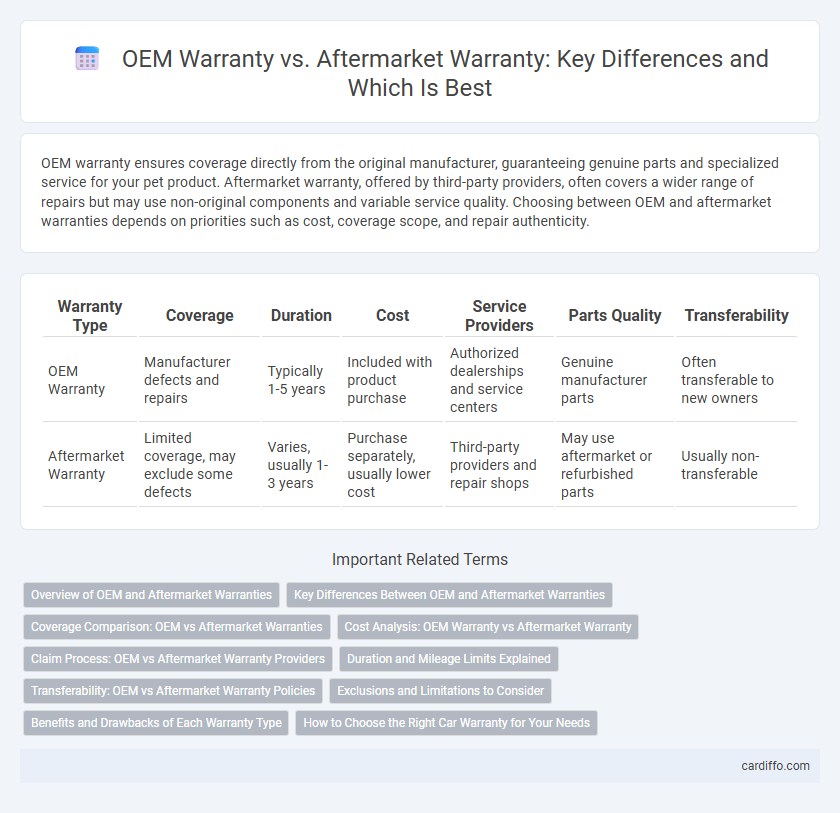OEM warranty ensures coverage directly from the original manufacturer, guaranteeing genuine parts and specialized service for your pet product. Aftermarket warranty, offered by third-party providers, often covers a wider range of repairs but may use non-original components and variable service quality. Choosing between OEM and aftermarket warranties depends on priorities such as cost, coverage scope, and repair authenticity.
Table of Comparison
| Warranty Type | Coverage | Duration | Cost | Service Providers | Parts Quality | Transferability |
|---|---|---|---|---|---|---|
| OEM Warranty | Manufacturer defects and repairs | Typically 1-5 years | Included with product purchase | Authorized dealerships and service centers | Genuine manufacturer parts | Often transferable to new owners |
| Aftermarket Warranty | Limited coverage, may exclude some defects | Varies, usually 1-3 years | Purchase separately, usually lower cost | Third-party providers and repair shops | May use aftermarket or refurbished parts | Usually non-transferable |
Overview of OEM and Aftermarket Warranties
OEM warranties are provided by the original equipment manufacturer and typically cover repairs and replacements with genuine parts for a specified period, ensuring product authenticity and maintaining manufacturer standards. Aftermarket warranties are offered by third-party companies and often provide more flexible coverage options, including extended periods and a wider range of service providers, but may exclude manufacturer defects or use non-original parts. Consumers should evaluate coverage scope, cost, and service quality when choosing between OEM and aftermarket warranties for optimal protection.
Key Differences Between OEM and Aftermarket Warranties
OEM warranties are provided by the original manufacturer and typically cover parts and labor for a specific period, ensuring compatibility and quality aligned with the product's specifications. Aftermarket warranties, offered by third-party providers, often extend coverage beyond OEM terms but may have limited scope and stricter claim conditions. Key differences include coverage scope, claim process, repair quality, and potential impact on the product's resale value.
Coverage Comparison: OEM vs Aftermarket Warranties
OEM warranties typically offer comprehensive coverage, including parts, labor, and repairs using original manufacturer components with strict adherence to quality standards. Aftermarket warranties often provide limited coverage, focusing primarily on major components and may exclude certain repairs or require using non-original parts. Consumers seeking extensive protection and guaranteed compatibility generally benefit more from OEM warranties compared to the often restrictive scope of aftermarket options.
Cost Analysis: OEM Warranty vs Aftermarket Warranty
OEM warranties typically involve higher upfront costs but provide comprehensive coverage backed by the original manufacturer, often including genuine parts and authorized service centers. Aftermarket warranties offer more affordable options with flexible terms but may have limited coverage, exclude certain repairs, or require out-of-pocket expenses for specific parts or services. Cost analysis reveals that OEM warranties generally ensure long-term value and reliability, while aftermarket warranties suit budget-conscious customers prioritizing immediate savings over extensive protection.
Claim Process: OEM vs Aftermarket Warranty Providers
OEM warranty claim processes typically involve authorized dealerships or service centers that use original parts and follow manufacturer-specific protocols, ensuring consistent repair quality and faster approvals. Aftermarket warranty providers often have more flexible claim procedures, allowing broader service options but can entail longer verification times and potential part compatibility issues. Consumers should weigh the trade-offs between OEM's streamlined, brand-aligned claims and aftermarket's extended coverage with variable service standards.
Duration and Mileage Limits Explained
OEM warranties typically offer longer duration and higher mileage limits, often covering 3 to 5 years or 36,000 to 60,000 miles, ensuring comprehensive protection aligned with the vehicle's original specifications. Aftermarket warranties generally provide shorter coverage periods with lower mileage caps, commonly ranging from 1 to 3 years and 12,000 to 36,000 miles, focusing on specific components or repairs. Understanding these differences helps consumers choose the most suitable warranty based on driving habits and desired coverage length.
Transferability: OEM vs Aftermarket Warranty Policies
OEM warranties typically offer limited or no transferability, binding the coverage strictly to the original purchaser to maintain manufacturer control and prevent misuse. Aftermarket warranties often provide broader transferability options, allowing subsequent owners to benefit from continued coverage and increasing the vehicle's resale value. Transferability policies directly impact warranty appeal and influence consumer decisions when buying new or used vehicles.
Exclusions and Limitations to Consider
OEM warranty typically covers defects in materials and workmanship with strict adherence to the original manufacturer's specifications, but often excludes damage caused by improper installation, modifications, or use of non-OEM parts. Aftermarket warranties may offer broader coverage options but frequently impose limitations such as shorter terms, reduced coverage on certain components, and exclusions for pre-existing conditions or non-certified repairs. Understanding these exclusions and limitations is crucial to ensure that warranty claims align with the scope of coverage provided by either OEM or aftermarket warranties.
Benefits and Drawbacks of Each Warranty Type
OEM warranty offers comprehensive coverage with manufacturer-approved parts and repairs, ensuring quality and reliability but often comes with higher costs and limited flexibility. Aftermarket warranty provides more affordable and customizable options, covering a wider range of repairs and sometimes extending beyond OEM terms, though it may involve non-OEM parts and variable service quality. Choosing between OEM and aftermarket warranties depends on factors such as cost sensitivity, desired coverage scope, and preference for brand-authenticated servicing.
How to Choose the Right Car Warranty for Your Needs
Choosing the right car warranty depends on evaluating OEM warranties, which offer manufacturer-backed coverage with genuine parts and often higher resale value, against aftermarket warranties that provide customizable plans and extended protection. Consider factors like coverage duration, cost, parts quality, and claim process transparency to ensure the warranty aligns with your vehicle's age, mileage, and usage. Prioritize warranties that offer comprehensive protection for critical components and reliable customer support to maximize long-term savings and vehicle performance.
OEM Warranty vs Aftermarket Warranty Infographic

 cardiffo.com
cardiffo.com